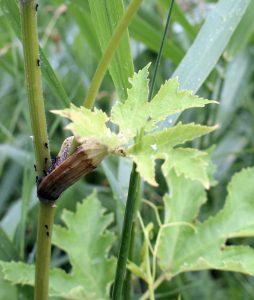Common Cow Parsnip
 Heracleum maximum, is a native biennial (or short-lived perennial) and the only Heracleum native to N. America — this as opposed to the highly invasive, monstrous giant hogweed (Heracleum mantegazzianum) with which common cow parsnip often gets confused. Common cow parsnip, also known as ‘American cow parsnip’, is a member of the Carrot family. The leaves provide a very easy ID, for they are large and palmately compound in 3s. The leaf stalk is sheathed where it clasps the stem. Tiny white flowers form on the ends of the branching flower stalks in flat clusters (termed ‘compound umbels’ in botany) consisting of smaller clusters (called ‘umbellets’) of up to 30 little white flowers, just 1/4 inch across. The 5 white petals are deeply notched at the tip making it seem like ten petals, and the petals are of uneven size. Five white-tipped stamens surround a button dot of creamy yellow. Bloom period (depending on the region of Minnesota) starts in May and lasts about a month, in general May through July.
Heracleum maximum, is a native biennial (or short-lived perennial) and the only Heracleum native to N. America — this as opposed to the highly invasive, monstrous giant hogweed (Heracleum mantegazzianum) with which common cow parsnip often gets confused. Common cow parsnip, also known as ‘American cow parsnip’, is a member of the Carrot family. The leaves provide a very easy ID, for they are large and palmately compound in 3s. The leaf stalk is sheathed where it clasps the stem. Tiny white flowers form on the ends of the branching flower stalks in flat clusters (termed ‘compound umbels’ in botany) consisting of smaller clusters (called ‘umbellets’) of up to 30 little white flowers, just 1/4 inch across. The 5 white petals are deeply notched at the tip making it seem like ten petals, and the petals are of uneven size. Five white-tipped stamens surround a button dot of creamy yellow. Bloom period (depending on the region of Minnesota) starts in May and lasts about a month, in general May through July.

Filled with nectar and pollen and easily accessible due to its large umbels, this plant attracts a wide variety of insects including butterflies, many species of bees, flies, wasps and beetles. I have also seen columns of ants marching up and down the stems, similar to what happens on peonies. Heracleum, by the way, is one of the host plants for the anise swallowtail butterfly, a beautiful black and yellow butterfly with a wing span of up to 3 inches.
If handling this plant, wear gloves, for like some other members of the Carrot family (Angelica, and other species of parsnip) the leaves and outer stem can cause skin rashes and blisters when the sap reacts with sunlight on your skin. Another member of the Carrot family, bulblet-bearing water hemlock, is actually life-threatening if consumed, so be aware and informed!
In comparison to Carrot family species like hemlocks and the much more poisonous member of its own genus, giant hogweed, common cow parsnip does indeed emerge as the tamer one, but still take care around it. Medicinal traditions for this plant include using it as a poultice for boils. A decoction of the roots is used for sore throats. Common cow parsnip roots are also edible, traditionally boiled (twice) and said to resemble the taste of rutabaga.
